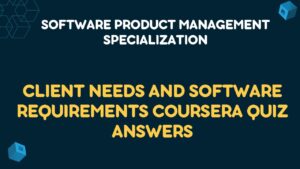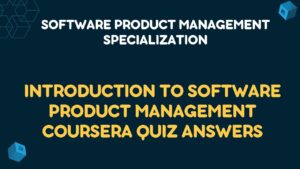Table of Contents
Build Wireframes and Low-Fidelity Prototypes Week 1 Quiz Answers
Optional – Test your knowledge of prior concepts Quiz Answers
Q1. What are some key benefits of considering accessibility in UX design? Select all that apply.
- Creates solutions that often help everyone
- Addresses societal structures and products rather than a person’s ability
- Ensures underrepresented and excluded groups are taken into account
Q2. Which phase of the design sprint helps the team find solutions to build on?
- Test
- Decide
- Ideate
- Understand
- Prototype
Q3. What can a researcher learn when they properly empathize with users during user research?
- The wants, desires, and fears of their users
- The hopes, dreams, and assumptions of their users
- The opinions, feelings, and biases of their users
- The needs, behaviors, and motivations of their users
Q4. Which of the following are examples of pain points? Select all that apply.
- Receiving the same response to three different questions from an automated chatbot
- Struggling to interact with a button on a mobile app’s homepage because it’s extremely small
- Completing the checkout process for a food delivery app
- Being asked to submit credit card information when no payment is required
Q5. Which of the following statements about user personas is true?
- A persona is a real user who provides real reviews on a product.
- Personas can help identify patterns of behavior in users.
- Personas are modeled after the characteristics of the UX designer.
- UX designers should avoid creating backstories for personas
Q6. Which of these user stories includes a type of user, an action, and a benefit?
- As a yoga instructor, I want to create a consistent class schedule so that my clients know how to confidently plan their weekly exercise.
- As a scientist, I want access to my colleagues’ published research.
- I want a bookshelf so I have somewhere to store my book collection.
- As a chef, I want access to the freshest ingredients and the highest-quality cooking utensils.
Q7. Fill in the blank: Designing products with accessibility and inclusivity in mind ensures that you _____.
- focus on creating one solution for as many people as possible
- create an identical experience for all users
- include solutions that benefit specific individuals, which improves the user experience for all users.
- create a different solution for every single user.
Q8. Which of the following is a complete problem statement?
- Angelo needs a toolbox and shingles to fix the leak in their roof.
- Akiko is a construction consultant who is building a skyscraper.
- Bella is a dance choreographer who needs to create a practice video because some of their students have school during the day and can’t attend lessons in person.
- Hakim is an accountant who needs to collect expense reports from their coworkers.
Q9. Identify the steps of the ideation process in the correct order.
- Brainstorming, documenting ideas, focusing on quantity, gathering a diverse team, questioning obvious solutions, and evaluating the ideas.
- Gathering a diverse team, brainstorming, documenting ideas, questioning obvious solutions, focusing on quantity, and evaluating the ideas.
- Documenting ideas, brainstorming, focusing on quantity, questioning obvious solutions, gathering a diverse team, and evaluating the ideas.
Q10. You’re a UX designer working on a gaming app in a competitive market space. You want to figure out what your competitors’ strengths and weaknesses are, and how to create a better product. What should you do?
- Contact each company directly
- Create a marketing plan
- Conduct informal research online
- Conduct a competitive audit
Test your knowledge of storyboards Quiz Answers
Q1. What are the key elements of a storyboard? Select all that apply.
- Character
- Scene
- Narrative
- Theme
- Plot
Q2. Which of the following scenarios would be most appropriate to use a big picture storyboard?
- You create a tool that connects auto mechanics with local auto parts stores to check product availability in real-time. You want to test the app for possible connection issues.
- You create a new homepage for a news site. You need to show the details of the product and what happens during each step of the user experience.
- You start the design process for a new grocery delivery app. You want to pitch some ideas to the team about how the user could use it and benefit from it.
Build Wireframes and Low-Fidelity Prototypes Week 2 Quiz Answers
Test your knowledge on information architecture Quiz Answers
Q1. What does information architecture (IA) do?
- Organizes content to help users understand where they are in a product, and where the information they want is.
- Visually describes and explores a user’s experience with a product
- Inspires architecture-related UX designs
- Creates a basic outline of a digital experience, like an app or website
Q2. How does information architecture (IA) support the wireframe creation process?
- Provides clearer direction and understanding
- Makes the final product easy to use
- Organizes an app into lines and rectangles
- Provides a detailed view of the final product
Q3. Fill in the blank: Information architecture helps engineers _____.
- create new designs
- make designs look better
- understand user needs
- organize data
Test your knowledge on Gestalt Principles Quiz Answers
Q1. Fill in the blank: Similarity, proximity, and common region are examples of Gestalt Principles. Designers can use these principles to _____ content so it is visually pleasing and easier to understand.
- organize
- recognize
- evaluate
Q2. You are developing a website for a clothing resale company. On the homepage, you choose to display the top-selling brands, by logo, in the center of the page. The logos are grouped with a border around them. Which of the following Gestalt Principles apply in this scenario?
- Similarity
- Proximity
- Common region
Q3. To adhere to the Gestalt principle of proximity, what should a designer do?
- Make elements that have a similar function look similar
- Use borders to group elements together
- Put elements closer together
Q4. Fill in the blank: Gestalt principles describe how humans _____ similar elements, recognize patterns, and simplify complex images when they perceive objects.
- describe
- group
- create
- disassemble
Build Wireframes and Low-Fidelity Prototypes Week 3 Quiz Answers
Test your knowledge of low-fidelity prototypes Quiz Answers
Q1. You demonstrate an early product model’s scrolling and click functionality to stakeholders before it goes to engineering. What are you demonstrating?
- A design type
- A prototype
- A wireframe
- A storyboard
Q2. What is the most significant difference between a wireframe and a prototype?
- Interactivity
- Fidelity
- Cost
- Time
Q3. What is the goal of creating a low-fidelity prototype?
- Make it easier for engineers to value the design
- Create a complex and interactive design that’s ready for development
- Make designs testable to collect and analyze feedback early on
- Create a complex and static design to show stakeholders
Get Google UX Design Professional Certificate Course Quiz Answers
Foundations of User Experience (UX) Design Quiz Answers
Start the UX Design Process: Empathize, Define, and Ideate Quiz Answers
Build Wireframes and Low-Fidelity Prototypes Quiz Answers
Conduct UX Research and Test Early Concepts Quiz Answers
Create High-Fidelity Designs and Prototypes in Figma Quiz Answers
Responsive Web Design in Adobe XD Quiz Answers
Design a User Experience for Social Good & Prepare for Jobs Quiz Answers




